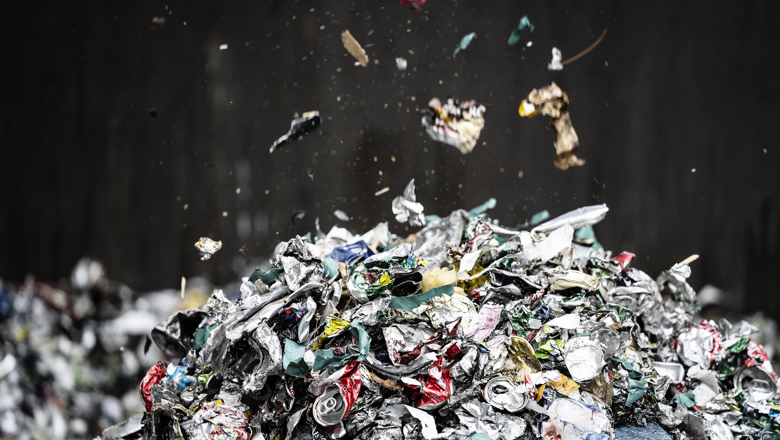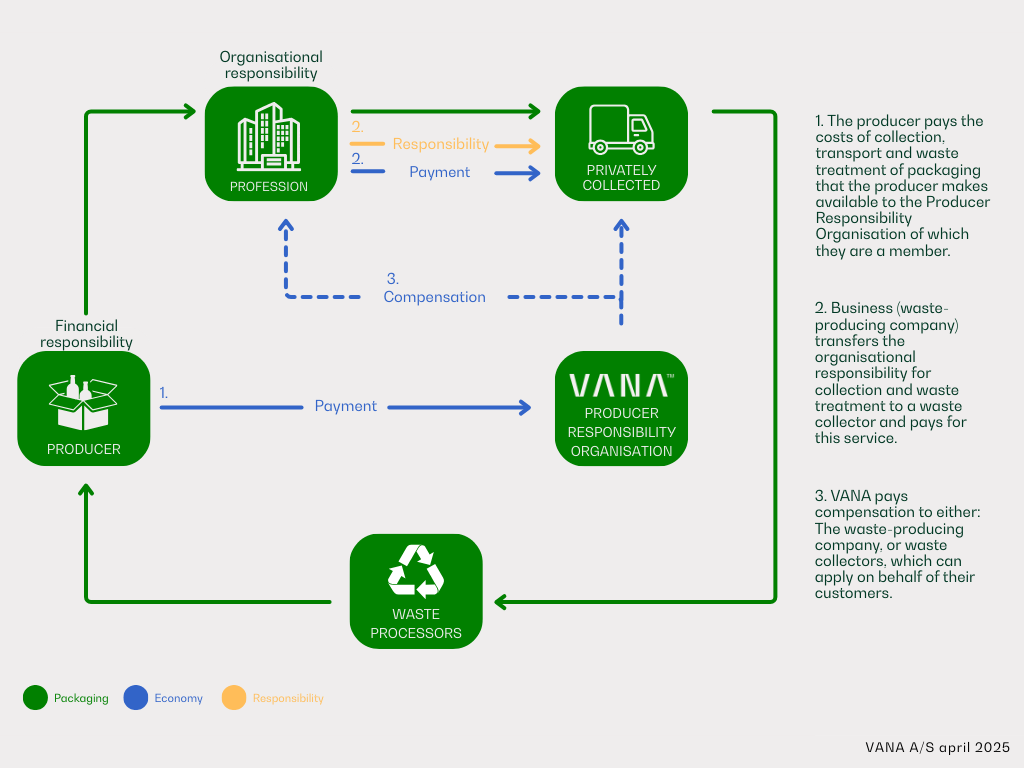Waste treatment

Companies are given financial responsibility for the collection, sorting, and treatment of their packaging when it becomes waste - both from households and businesses - with the producer responsibility. For household waste, producers also have the organisational (practical) responsibility for waste treatment. For commercial waste, the waste-producing businesses have the organisational (practical) responsibility.
Difference between producer and waste-producing company
Producer is a company that places packaging and/or filled packaging on the market.
They have the financial (economic) responsibility for the waste treatment of their packaging sold to both households and businesses (waste-producing companies).
Waste-producing company is a company that is the end-user of packaging waste (turns it into waste). They have the organisational (practical) responsibility for ensuring that the waste is treated – just as they have always had and done.

Household Waste
The producers have, through the Producer Responsibility Organisation (PRO), the financial (economic) responsibility for the collection, sorting, and treatment of packaging. The organisational (practical) responsibility is shared between the municipality and the Producer Responsibility Organisation (PRO). Municipalities are responsible for collection in households, and the Producer Responsibility Organisation (PRO) is responsible for waste treatment. The Producer Responsibility Organisation (PRO) only need to cover the costs for the part of the waste that comprises packaging:
- Citizens purchase packaged products, after which the packages become waste. Municipalities are responsible for the collection in households. The Producer Responsibility Organisation (PRO) pays a fee to the municipality as compensation for the collection of packaging in the waste. The waste is transferred to the Producer Responsibility Organisation (PRO). Citizens pay through their waste collection fee for the part of the waste that is not packaging.
- The Producer Responsibility Organisation (PRO) has the organisational responsibility to ensure that the waste is treated and recycled. The Producer Responsibility Organisation (PRO) is compensated by the municipality for the part of the waste that is not packaging.
Commercial Waste
The waste-producing business has the organisational (practical) responsibility for ensuring that the packaging waste is treated. The packaging waste is usually transferred to private waste collectors.
- The waste-producing business (commercial) purchases packaged products, after which the packages become waste. The business makes an agreement with a private waste collector that ensures the collection, sorting, and recycling of the packaging waste.
Compensation
Producers have the financial (economic) responsibility for the packaging they place on the market that ends up in commercial waste. They pay costs for this to the Producer Responsibility Organisation (PRO) of which they are a member.
Waste-producing businesses can apply for compensation for their expenses related to the collection and treatment of packaging waste. The business still pays for the part of the waste that is not packaging.
The Producer Responsibility Organisation (PRO) disburses compensation for the costs of handling commercial packaging waste to either the:
- waste-producing business or
- waste collectors who apply on behalf of their customers.
VANA is working on the specific model for compensation disbursement and is continuously updating it.

Requests for compensation must be directed to the Producer Responsibility Organisation (PRO) that has been assigned the payment obligation for the fraction and municipality in which the waste-producing company is physically located according to its p-number. The fractions that can be applied for are:
- Paper packaging waste.
- Cardboard packaging waste.
- Metal packaging waste.
- Glass packaging waste.
- Plastic packaging waste.
- Food and beverage carton packaging waste.
- Wood packaging waste.
- Packaging waste correctly sorted as residual waste.
- Packaging waste in hazardous waste.
To calculate how much producers (via VANA) must pay to the waste-producing companies for commercial packaging waste, key figures set by the Environmental Protection Agency must be used. The key figures are regulated once a year and published on the Environmental Protection Agency's website.
Calculation
Compensation calculation is based on the guidelines stated in the statutory order on packaging appendix 12 (Danish).
VANA calculates the payment for collection, transport, and treatment of commercial packaging waste from waste producers using the formulas below:
- Amount to be paid = number of tons * distribution key for packaging share * (key figure for collection + key figure for treatment).
For combined collection, the following formula is used:
- Amount to be paid = number of tons * distribution key for combined collection * distribution key for packaging share
* (key figure for collection + key figure for treatment).
Definitions for calculation formulas
The number of tons is the quantity of waste the waste producer has produced and requested payment for within the given payment period.
The distribution key for the packaging share are the distribution keys found in table 4-7 in appendix 8. The producer must use these distribution keys when calculating the costs.
The distribution key for combined collection are the distribution keys found in table 2 in appendix 8 for waste fractions collected through municipal collection schemes that are collected via combined collection. The producer must use these distribution keys when calculating the costs.
Key figures for collection and key figures for treatment constitute a total market price for collection, transport, and treatment, including pre-treatment and marketing of waste materials. In calculating the payment, the producer must use key figures for costs for both collection and treatment, which are set by the Environmental Protection Agency. The producer must use the key figures that are valid at any given time, which at the time of the calculation are available on the Environmental Protection Agency's website, cf. § 68.
The Environmental Protection Agency sets key figures for collection and treatment of commercial waste based on a basic figure for the current market price for both treatment and transport.
The base figures are continuously regulated for price, among other things, by using indices for selling prices and multiplied by price efficiency factors to adjust the key figures so that they reflect effective collection and marketing.
Returned quantities:
- Companies that have returned their own packaging waste and report this as returned to their Producer Responsibility Organisation cannot simultaneously apply for compensation for the collection, transport, and treatment of commercial packaging waste that originates from the company's made available packaging.
Waste that is included in a municipal collection or drop-off scheme:
- Waste-producing companies that have their waste collected as part of a municipal household collection or that deliver their waste in a drop-off scheme (recycling stations) cannot apply for compensation, as the costs for packaging waste are covered by the municipality's fee for collection, which is included in the producer responsibility. This means that the fee for collection or use of the recycling station should be lower.
- Waste-producing companies that have their waste collected by a municipality that collects commercial waste separately from household waste cannot apply for compensation, as this right to compensation has been transferred to the municipality.
Packaging waste with profit:
- Waste-producing companies that have packaging waste that is sold at a profit (including collection, transport, and waste treatment) do not need to request payment.
